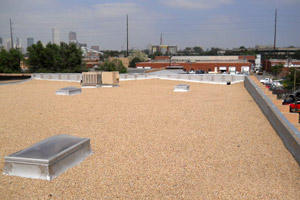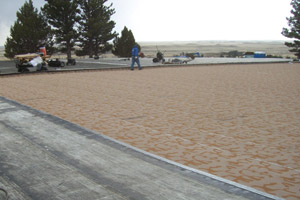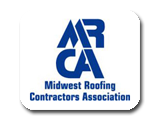Built Up & Modified
 Built-up roof membranes: also known by the acronym BUR, are commonly referred to as "tar and gravel" roofs. BUR systems generally are composed of alternating layers of bitumen and reinforcing fabrics that create a finished membrane. The number of plies in a cross section is the number of plies on a roof: The term "four plies" denotes a four ply roof membrane construction. Sometimes, a base sheet, used as the bottommost ply, is mechanically fastened. Built up roofs generally are considered to be fully adhered if applied directly to roof decks or insulation.
Built-up roof membranes: also known by the acronym BUR, are commonly referred to as "tar and gravel" roofs. BUR systems generally are composed of alternating layers of bitumen and reinforcing fabrics that create a finished membrane. The number of plies in a cross section is the number of plies on a roof: The term "four plies" denotes a four ply roof membrane construction. Sometimes, a base sheet, used as the bottommost ply, is mechanically fastened. Built up roofs generally are considered to be fully adhered if applied directly to roof decks or insulation.
The reinforcing fabrics also are called roofing felts or ply sheets. Roofing felts are reinforced with either glass-fiber mats or organic mats. Felts are produced in a standard width of 36 inches and metric width of about one meter.
The bitumen typically used in BUR roof systems is asphalt, coal tar or cold-applied adhesive. The asphalt or coal tar is heated in a kettle or tanker and then applied by mop or mechanical spreader. Asphalt is a petroleum product refined from crude oil; coal tar is derived from the distillation of coal. Cold-applied adhesives typically are solvent-based asphalts that don't have to be heated in a kettle or tanker.
Surfacing for built up roof systems include aggregate (such as gravel, slag or mineral granules), glass-fiber or mineral surfaced cap sheets, hot asphalt mopped over the entire surface, aluminum coatings or elastomeric coatings.
Modified: Polymer-modified bitumen or modified bitumen (MB) sheet membranes were developed in Europe in the early 1960s and have been in use in the U.S. since the mid 1970s. Polymer-modified roof membranes are composed of reinforcing fabrics that serve as carriers for the hot polymer-modified bitumen as it is manufactured into a roll material. MB roof system membranes are composed of multiple layers, much like BUR membranes. MB roof systems typically are installed as a two-ply system and almost always are fully adhered.
 There are two types of MB roofing membranes:
There are two types of MB roofing membranes:
- SBS polymer-modified bitumen membranes commonly are installed in hot moppings of asphalt (similar to BUR systems) or cold adhesive. Some SBS modified membranes are self adhering; that is, they contain an adhesive backing.
- APP polymer-modified bitumen membranes typically are heat-welded or torch-applied. Consumers should be cautioned that NRCA does not recommend torch-applying a modified bitumen membrane sheet directly to a wood deck.
Generally, APP modifiers impart a "plasticized" quality to asphalt, and SBS modifiers impart a "rubberized" quality to asphalt. MB membranes and EPDM, a thermoset membrane, often are confused by consumers because of colloquialisms used by roofing contractors. MB and EPDM membranes are sometimes called "rubber roofs."
Surfacing for MB membranes include aggregate surfacing, mineral surfacing, metal foil-laminate surfacing and smooth liquid-applied surfacing.
A roof system composed of a built up roof membrane with 2 plies or 3 plies and a polymer-modified bitumen membrane cap sheet is commonly referred to as "hybrid" system.




